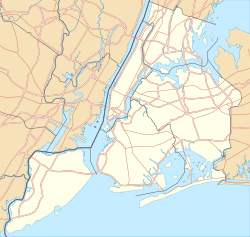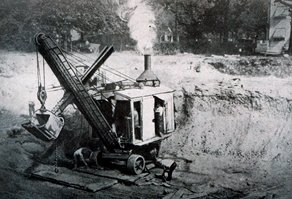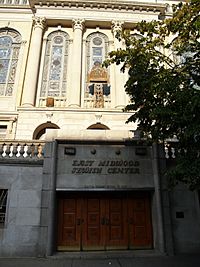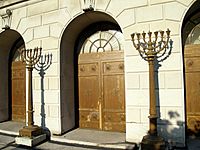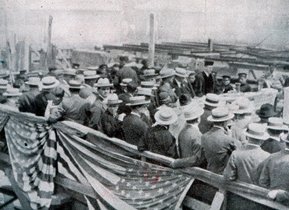East Midwood Jewish Center facts for kids
Quick facts for kids East Midwood Jewish Center |
|
|---|---|
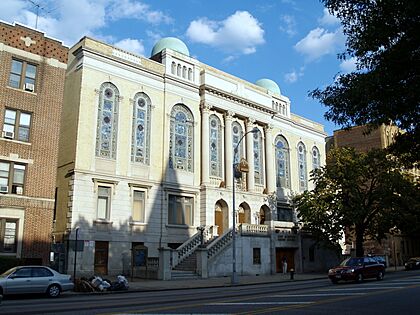
East Midwood Jewish Center in Brooklyn, in 2008
|
|
| Religion | |
| Affiliation | Conservative Judaism |
| Ecclesiastical or organizational status | Synagogue |
| Leadership |
|
| Status | Active |
| Location | |
| Location | 1625 Ocean Avenue, Midwood, Brooklyn, New York City, New York |
| Country | United States |
| Architecture | |
| Architect(s) |
|
| Architectural type | Synagogue |
| Architectural style | Renaissance Revival |
| Date established | 1924 (as a congregation) |
| Groundbreaking | 1926 |
| Completed | 1929 |
| Construction cost | $1 million (today $17 million ) |
| Specifications | |
| Direction of façade | West |
| Capacity |
|
| Width | 155 feet (47 m) |
| Dome(s) | 2 |
| Materials | Steel frame, masonry, buff and red brick, limestone, copper domes |
The East Midwood Jewish Center is a special place for Jewish people in Brooklyn, New York City. It is a synagogue, which is a Jewish house of worship. It follows the Conservative tradition, which is a type of Judaism.
The center was started in 1924. Its beautiful building, finished in 1929, was designed in a style called Renaissance Revival. This means it looks like buildings from the Renaissance period. It was built to be more than just a synagogue; it was a community center too. For many years, it was the only synagogue in Brooklyn with a working swimming pool!
The building has stayed mostly the same since it was built. Because of its history and unique design, it was added to the National Register of Historic Places in 2006.
Over the years, the center has grown. It even welcomed members from other synagogues in Brooklyn. It also has a long history of important rabbis who have led the community.
Contents
History of the Center
How It Started
The East Midwood Jewish Center began in 1924. A dentist named Jacob R. Schwartz wanted his sons to have a nearby Hebrew school. He decided to create a Conservative synagogue.
Conservative Judaism tries to find a middle ground. It has traditional Hebrew services like Orthodox synagogues. But it also includes some English prayers, like Reform synagogues.
The first meeting was on November 18, 1924. Pincus Weinberg was chosen as the first president. The first rabbi was Reuben Kaufman, and the first cantor was Jacob Schraeter.
Building the Synagogue
The leaders first bought land on Avenue L. But most members wanted a spot on Ocean Avenue. So, in 1925, they bought the current location at 1625 Ocean Avenue.
The first stone was laid in 1926. Even though it wasn't fully finished, they held High Holiday services there that year. The Center's Talmud Torah (a Jewish school) also moved into the new building.
The building was completed in 1929. It cost about $1 million back then. It was designed to be a "synagogue-center." This meant it had a synagogue, an auditorium, kitchens, classrooms, a gym, and a swimming pool.
In 1929, Rabbi Reuben Kaufman left. Harry Halpern became the new rabbi. Rabbi Halpern served the center for 49 years! He retired in 1977.
Challenges and Growth
During the Great Depression, many people faced money problems. The synagogue also struggled, and membership went down. To help, they raised membership fees and found other ways to save money.
But the synagogue survived! By 1934, it had 300 members. By 1944, it had grown to 1,100 families.
From 1955 to 1985, Abraham Nadel was the Choral Director. He was famous for his choir and music. Joseph Eidelson became the cantor in 1956. He had been a cantor in Poland and Lithuania before.
In 1968, Mayor of New York City John Lindsay visited the center. There was a big argument happening in the city about schools. Many people were upset, and the mayor faced a large crowd.
After Rabbi Halpern retired in 1977, Alvin Kass became the new rabbi. Rabbi Kass was a graduate of Columbia College and New York University.
Recent Years
As the neighborhood changed, the East Midwood Jewish Center welcomed other Conservative synagogues. This included the Jewish Communal Center of Flatbush and Congregation Shaare Torah. By 1996, there were 1,000 families as members.
The synagogue building has stayed the same since it was built. It was the only synagogue in Brooklyn with a working swimming pool until 2010. In 2006, it was added to the National Register of Historic Places.
The center has also worked to keep its building in good shape. It received loans and grants for repairs. This helped fix the masonry, steel, stained glass windows, and dome.
Aaron Pomerantz joined as an associate rabbi in 1978. He had escaped Europe during World War II. He served until his death in 2009. Joseph Eidelson retired as Cantor Emeritus in 1995.
Sam Levene became the center's cantor in 2004. He was born in Jerusalem and grew up in Toronto.
Rabbi Kass retired in 2014 and became Rabbi Emeritus. He also served as a New York City Police Department chaplain for over 40 years. He even helped solve a hostage situation once! He also helped Jewish police officers get time off for the Sabbath.
Matt Carl became the rabbi in 2014. He had been a rabbi at other synagogues in Manhattan and Brooklyn.
East Midwood Day School
The East Midwood Jewish Center had a successful Talmud Torah. This was for Jewish instruction after school. Famous author Susan Brownmiller attended it as a child.
In 1950, the center built a three-story school building. At its busiest in the early 1950s, almost 1,000 students attended the school.
Later, the center started a Jewish day school. This school taught students from kindergarten to 8th grade. It also offered religious classes for public school students. The school was later named the Rabbi Harry Halpern Day School.
Over time, the day school faced challenges. Its enrollment dropped. In 2009, the synagogue and school made a new agreement to work more closely. In 2018, the day school changed and became more focused on the Orthodox tradition. The Talmud Torah still operates as a school for the congregation.
Building Design
The exact architect of the East Midwood Jewish Center building is not fully known. The design is officially credited to the Building Committee and Irving Warshaw.
However, some believe the architect was Louis Abramson. He designed many synagogue-centers in New York. His other buildings, like the Brooklyn Jewish Center, look very similar to East Midwood. It is thought that Abramson might have drawn the main plans, and the committee finished them to save money.
Another architect, Maurice Courland, also claimed the East Midwood Jewish Center as his work. He designed other synagogues and landmarks in New York.
Famous People
Some famous people have been part of the East Midwood Jewish Center.
Supreme Court Justice Ruth Bader Ginsburg was confirmed here. She also wrote essays for the synagogue's bulletin when she was 13. Her essays were about important topics like prejudice and world unity after the Holocaust.
Filmmaker Marc Levin was also a member. His grandfather, Herman Levin, was a president of the center. He also helped start the Reconstructionist movement.
Media Appearances
In 2018, parts of the TV show The Marvelous Mrs. Maisel were filmed at the East Midwood Jewish Center.


